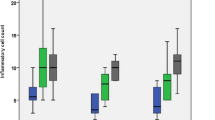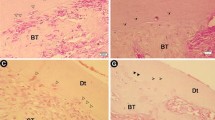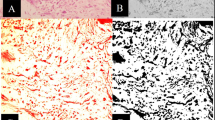Abstract
Objective
This study assessed tissue responses after furcation perforation and immediate sealing with either Biodentine™ or MTA Angelus™.
Material and methods
Sixty male Wistar rats were used (n = 6 per group/period). The mandibular first molars had the furcation mechanically exposed and sealed with either MTA or Biodentine™ and restored with silver amalgam. In an additional test group, teeth were sealed only with Biodentine™. Furcation sealing with gutta-percha and silver amalgam restoration served as positive control, and healthy untreated teeth were the negative control. Histological evaluation was performed after 14 or 21 days. Kruskal-Wallis and Dunn’s post hoc tests were performed to analyze the extent and intensity of tissue inflammation, bone resorption, and cementum repair (p < 0.05).
Results
Biodentine™ and MTA presented satisfactory results, showing a milder inflammatory response when compared to the control, regardless of the material used for coronal sealing and of the experimental period evaluated (p < 0.0001). All test groups showed less bone resorption than the positive control after 21 days (p < 0.05), and such differences were more pronounced in teeth restored with silver amalgam. Cementum repair was performed in 30% of MTA and Biodentine™ samples but not carried out in any positive control specimen.
Conclusions
Biodentine™ and MTA promoted similar responses when used to seal furcation perforations and should therefore be regarded as a promising alternative.
Clinical relevance
Knowledge about tissue responses to restorative materials is essential for improving root perforation sealing protocols. The present results showed that both Biodentine™ and MTA promoted appropriate periradicular tissue reactions in a preclinical test for evaluating furcation perforation treatments.





Similar content being viewed by others
References
Fuss Z, Trope M (1996) Root perforations: classification and treatment choices based on prognostic factors. Endod Dent Traumatol 12:255–264
Seltzer S, Sinai I, August D (1970) Periodontal effects of root perforations before and during endodontic procedures. J Dent Res 49:332–339
Alhadainy HA (1994) Root perforations. A review of literature. Oral Surg Oral Med Oral Pathol 78:368–374
Darvell BW, Wu RCT (2011) “MTA”—an hydraulic silicate cement: review update and setting reaction. Dent Mater 27:407–422. https://doi.org/10.1016/j.dental.2011.02.001
Parirokh M, Torabinejad M (2010) Mineral trioxide aggregate: a comprehensive literature review—part III: clinical applications, drawbacks, and mechanism of action. J Endod 36:400–413. https://doi.org/10.1016/j.joen.2009.09.009
Lee SJ, Monsef M, Torabinejad M (1993) Sealing ability of a mineral trioxide aggregate for repair of lateral root perforations. J Endod 19:541–544. https://doi.org/10.1016/S0099-2399(06)81282-3
Pitt Ford TR, Torabinejad M, McKendry DJ et al (1995) Use of mineral trioxide aggregate for repair of furcal perforations. Oral Surg Oral Med Oral Pathol Oral Radiol Endod 79:756–763
Haapasalo M, Parhar M, Huang X, Wei X, Lin J, Shen Y (2015) Clinical use of bioceramic materials. Endod Top 32:97–117. https://doi.org/10.1111/etp.12078
Parirokh M, Torabinejad M (2010) Mineral trioxide aggregate: a comprehensive literature review—part I: chemical, physical, and antibacterial properties. J Endod 36:16–27. https://doi.org/10.1016/j.joen.2009.09.006
Camilleri J (2015) Mineral trioxide aggregate: present and future developments. Endod Top 32:31–46. https://doi.org/10.1111/etp.12073
Marciano MA, Duarte MA, Camilleri J (2015) Dental discoloration caused by bismuth oxide in MTA in the presence of sodium hypochlorite. Clin Oral Investig 19:2201–2209. https://doi.org/10.1007/s00784-015-1466-8
Tran XV, Gorin C, Willig C, Baroukh B, Pellat B, Decup F, Opsahl Vital S, Chaussain C, Boukpessi T (2012) Effect of a calcium-silicate-based restorative cement on pulp repair. J Dent Res 91:1166–1171. https://doi.org/10.1177/0022034512460833
Nowicka A, Lipski M, Parafiniuk M, Sporniak-Tutak K, Lichota D, Kosierkiewicz A, Kaczmarek W, Buczkowska-Radlińska J (2013) Response of human dental pulp capped with biodentine and mineral trioxide aggregate. J Endod 39:743–747. https://doi.org/10.1016/j.joen.2013.01.005
Guneser MB, Akbulut MB, Eldeniz AU (2013) Effect of various endodontic irrigants on the push-out bond strength of biodentine and conventional root perforation repair materials. J Endod 39:380–384. https://doi.org/10.1016/j.joen.2012.11.033
Grech L, Mallia B, Camilleri J (2013) Investigation of the physical properties of tricalcium silicate cement-based root-end filling materials. Dent Mater 29:e20–e28. https://doi.org/10.1016/j.dental.2012.11.007
Zhou HM, Shen Y, Wang ZJ, Li L, Zheng YF, Häkkinen L, Haapasalo M (2013) In vitro cytotoxicity evaluation of a novel root repair material. J Endod 39:478–483. https://doi.org/10.1016/j.joen.2012.11.026
Han L, Okiji T (2011) Uptake of calcium and silicon released from calcium silicate-based endodontic materials into root canal dentine. Int Endod J 44:1081–1087. https://doi.org/10.1111/j.1365-2591.2011.01924.x
Zanini M, Sautier JM, Berdal A, Simon S (2012) Biodentine induces immortalized murine pulp cell differentiation into odontoblast-like cells and stimulates biomineralization. J Endod 38:1220–1226. https://doi.org/10.1016/j.joen.2012.04.018
Camilleri J (2015) Staining potential of neo MTA plus, MTA plus, and biodentine used for pulpotomy procedures. J Endod 41:1139–1145. https://doi.org/10.1016/j.joen.2015.02.032
Sinkar RC, Patil SS, Jogad NP, Gade VJ (2015) Comparison of sealing ability of ProRoot MTA, RetroMTA, and Biodentine as furcation repair materials: an ultraviolet spectrophotometric analysis. J Conserv Dent 18:445–448. https://doi.org/10.4103/0972-0707.168803
Koubi G, Colon P, Franquin JC, Hartmann A, Richard G, Faure MO, Lambert G (2013) Clinical evaluation of the performance and safety of a new dentine substitute, biodentine, in the restoration of posterior teeth—a prospective study. Clin Oral Investig 17:243–249. https://doi.org/10.1007/s00784-012-0701-9
Silva LAB, Pieroni KAMG, Nelson-Filho P, Silva RAB, Hernandéz-Gatón P, Lucisano MP, Paula-Silva FWG, de Queiroz AM (2017) Furcation perforation: periradicular tissue response to biodentine as a repair material by histopathologic and indirect immunofluorescence analyses. J Endod 43:1137–1142. doi: https://doi.org/10.1016/j.joen.2017 .02.001
Mahl CR, Fontanella V (2008) Evaluation by digital subtraction radiography of induced changes in the bone density of the female rat mandible. Dentomaxillofac Radiol 37:438–444. https://doi.org/10.1259/dmfr/58263510
Scarparo RK, Dondoni L, Bottcher DE et al (2011) Response to intracanal medication in immature teeth with pulp necrosis: an experimental model in rat molars. J Endod 37:1069–1073. https://doi.org/10.1016/j.joen.2011.05.014
Arens DE, Torabinejad M (1996) Repair of furcal perforations with mineral trioxide aggregate: two case reports. Oral Surg Oral Med Oral Pathol Oral Radiol Endod 82:84–88
Pace R, Giuliani V, Pagavino G (2008) Mineral trioxide aggregate as repair material for furcal perforation: case series. J Endod 34:1130–1133. https://doi.org/10.1016/j.joen.2008.05.019
Ibarrola JL, Biggs SG, Beeson TJ (2008) Repair of a large furcation perforation: a four-year follow-up. J Endod 34:617–619. https://doi.org/10.1016/j.joen.2008.01.017
Main C, Mirzayan N, Shabahang S, et al (2004) Repair of root perforations using mineral trioxide aggregate: a long-term study. J Endod 30:80–83. DOI: https://doi.org/10.1097/00004770-200402000-00004
Balla R, LoMonaco CJ, Skribner J, et al (1991) Histological study of furcation perforations treated with tricalcium phosphate, hydroxylapatite, amalgam, and life. J Endod 17:234–238. D OI: https://doi.org/10.1016/S0099-2399(06)81928-X
Dammaschke T (2010) Rat molar teeth as a study model for direct pulp capping research in dentistry. Lab Anim 44:1–6. https://doi.org/10.1258/la.2009.008120
Silva MJB, Caliari MV, Sobrinho APR, Vieira LQ, Arantes RME (2009) An in vivo experimental model to assess furcal lesions as a result of perforation. Int Endod J 42:922–929. https://doi.org/10.1111/j.1365-2591.2009.01595.x
Scarparo RK, Dondoni L, Böttcher DE, Grecca FS, Figueiredo JAP, Kantarci A, van Dyke TE, Batista EL Jr (2014) Intracanal delivery of Resolvin E1 controls inflammation in necrotic immature rat teeth. J Endod 40:678–682. https://doi.org/10.1016/j.joen.2013.12.037
Beavers RA, Bergenholtz G, Cox CF (1986) Periodontal wound healing following intentional root perforations in permanent teeth of Macaca mulatta. Int Endod J 19:36–44
Al-Daafas A, Al-Nazhan S (2007) Histological evaluation of contaminated furcal perforation in dogs’ teeth repaired by MTA with or without internal matrix. Oral Surg Oral Med Oral Pathol Oral Radiol Endod 103:e92–e99. https://doi.org/10.1016/j.tripleo.2006.09.007
Hartwell GR, England MC (1993) Healing of furcation perforations in primate teeth after repair with decalcified freeze-dried bone: a longitudinal study. J Endod 19:357–361. https://doi.org/10.1016/S0099-2399(06)81363-4
Vanni JR, Della-Bona Á, Figueiredo JAPD, Pedro G, Voss D, Kopper PMP (2011) Radiographic evaluation of furcal perforations sealed with different materials in dogs’ teeth. J Appl Oral Sci 19:421–425
Samiee M, Eghbal M, Parirokh M et al (2010) Repair of furcal perforation using a new endodontic cement. Clin Oral Investig 14:653–658. https://doi.org/10.1007/s00784-009-0351-8
Walton RE, Torabinejad M (2002) Principles and practice of endodontics, 3rd edn. W B Saunders Co., Oxford
Tawfik HE, Abu-Seida AM, Hashem AA, El-Khawlani MM (2016) Treatment of experimental furcation perforations with mineral trioxide aggregate, platelet rich plasma or platelet rich fibrin in dogs’ teeth. Exp Toxicol Pathol 68:321–327. https://doi.org/10.1016/j.etp.2016.03.004
Woods GL, Walker DH (1996) Detection of infection or infectious agents by use of cytologic and histologic stains. Clin Microbiol Rev 9:382–384
Tomás-Catalá CJ, Collado-González M, García-Bernal D (2018) Biocompatibility of new pulp-capping materials NeoMTA Plus, MTA repair HP, and Biodentine on human dental pulp stem cells. J Endod 44:126–132. https://doi.org/10.1016/j.joen.2017.07.017
Quintana RM, Jardine AP, Grechi TR, Grazziotin-Soares R, Ardenghi DM, Scarparo RK, Grecca FS, Kopper PMP (2018) Bone tissue reaction, setting time, solubility, and pH of root repair materials. Clin Oral Investig. https://doi.org/10.1007/s00784-018-2564-1 [Epub ahead of print]
Zhu YQ, Xia WW, Xia L (2003) Histological evaluation on repair of furcation perforation in dogs using mineral trioxide aggregate. Shanghai Kou Qiang Yi Xue 12:47–50
Perinpanayagam H, Al-Rabeah E (2009) Osteoblasts interact with MTA surfaces and express Runx2. Oral Surg Oral Med Oral Pathol Oral Radiol Endod 107:590–596. https://doi.org/10.1016/j.tripleo.2008.12.005
Alhadainy HA, Abdalla AI (1998) Artificial floor technique used for the repair of furcation perforations: a microleakage study. J Endod 24:33–35. https://doi.org/10.1016/S0099-2399(98)80209-4
Author information
Authors and Affiliations
Corresponding author
Ethics declarations
Conflict of interest
The authors declare that they have no conflicts of interest.
Ethical approval
This study was approved by the Animal Care and Use Committee of the Pontifical Catholic University of Rio Grande do Sul, Brazil (Process: 12/00320).
Informed consent
This article does not contain any studies with human participants. Informed consent is not required.
Additional information
Publisher’s note
Springer Nature remains neutral with regard to jurisdictional claims in published maps and institutional affiliations.
Rights and permissions
About this article
Cite this article
de Sousa Reis, M., Scarparo, R.K., Steier, L. et al. Periradicular inflammatory response, bone resorption, and cementum repair after sealing of furcation perforation with mineral trioxide aggregate (MTA Angelus™) or Biodentine™. Clin Oral Invest 23, 4019–4027 (2019). https://doi.org/10.1007/s00784-019-02833-z
Received:
Accepted:
Published:
Issue Date:
DOI: https://doi.org/10.1007/s00784-019-02833-z




